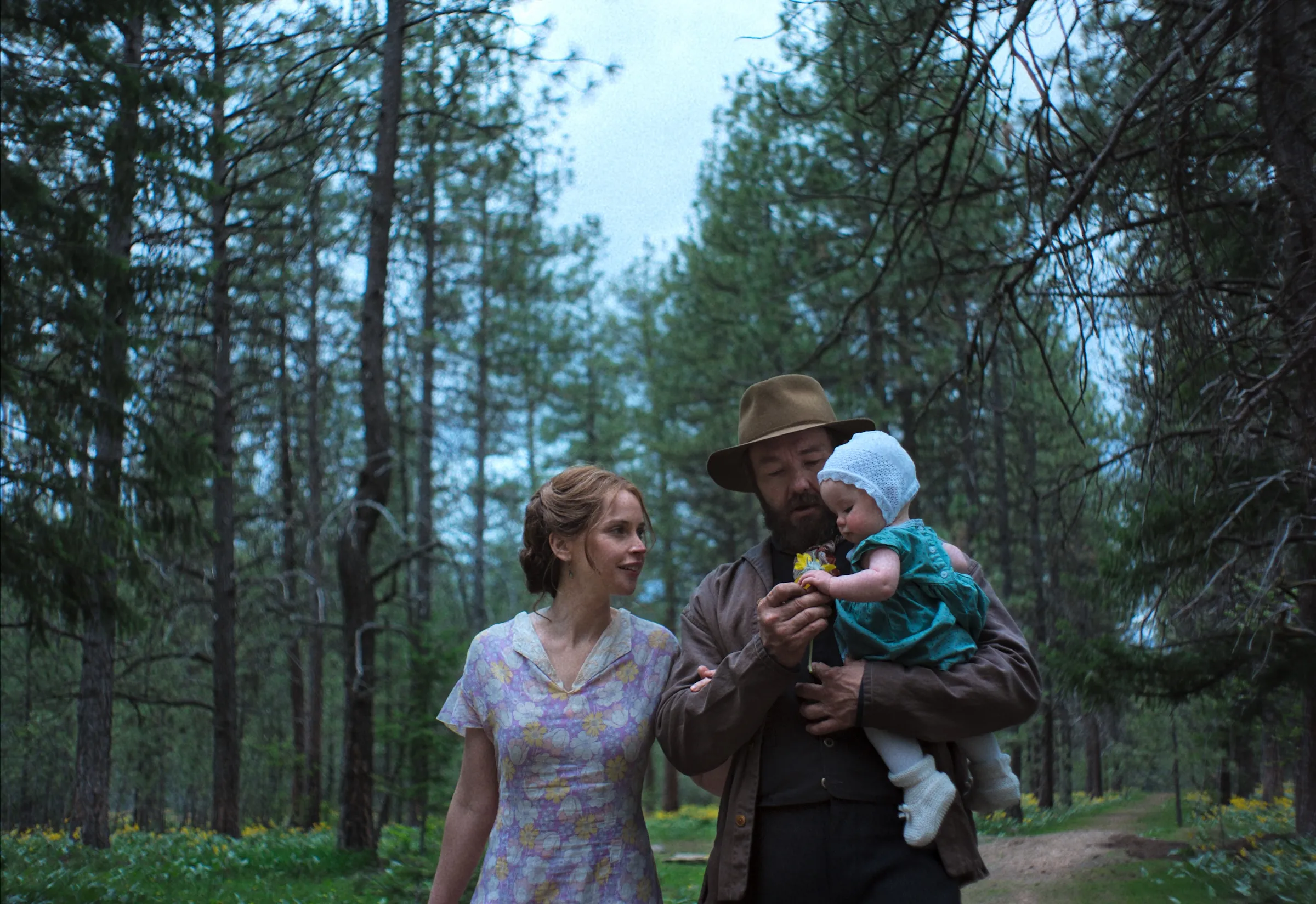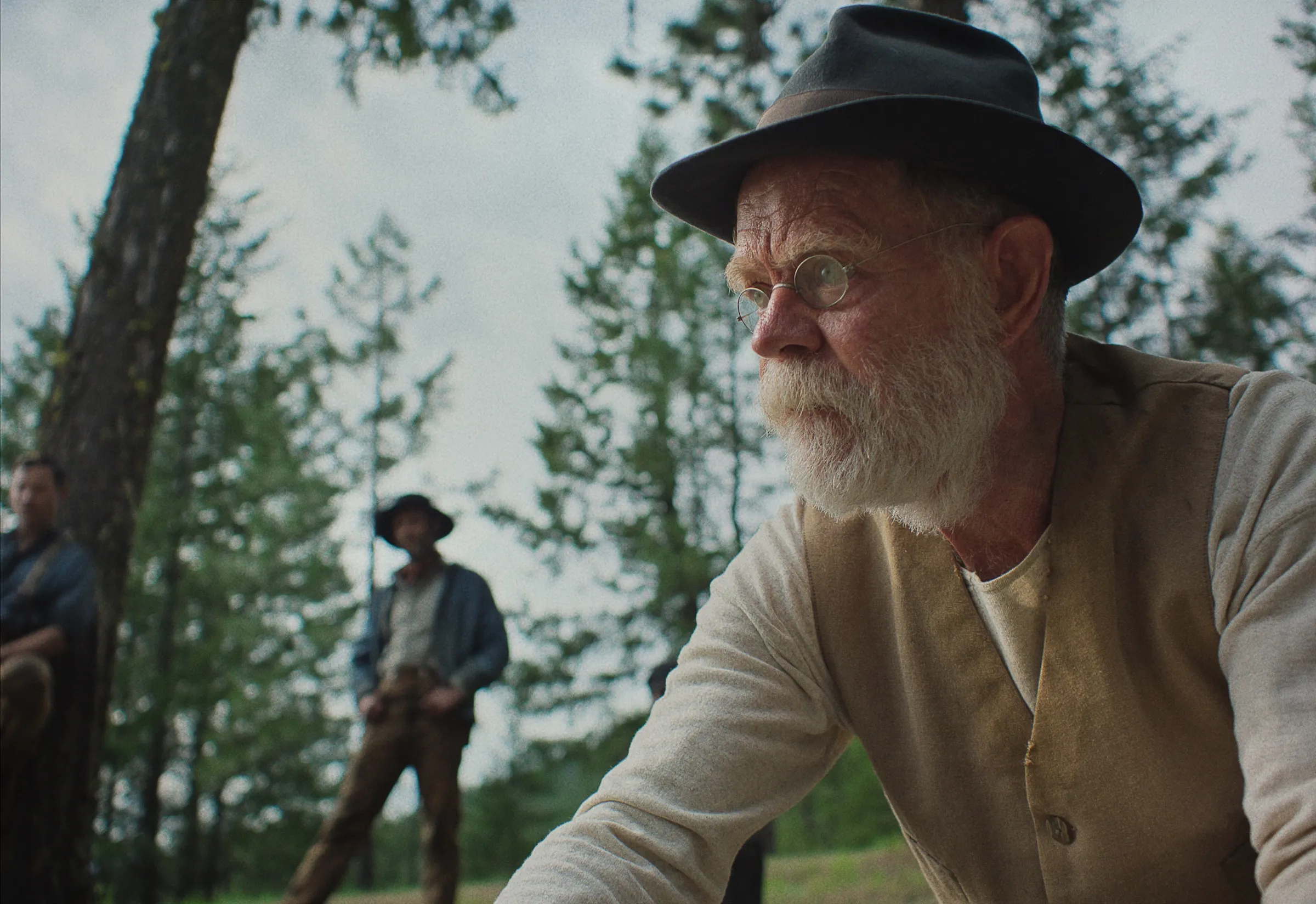In the forests of the Idaho Panhandle in 1917, modernity is picking up steam. Train Dreams, based on a novella by Denis Johnson, tells the story of laborer Robert Grainier (Joel Edgerton), a quiet, bearded fellow who moves between jobs that keep him away from his new family. He aides in the construction of a bridge that, he is told, will save Spokane International Railroad some 11 miles. The steam train will thunder through tunnels, across gorges, alongside thick treelines, a striking and ethereal moving image of modern progress that haunts Grainier. He spends his life in the margins of the first half of the American Century, daunted by its quick pace and only somewhat soothed by seeking refuge in nature, surrounded by Northwestern trees, streams, and valleys—but rarely other people.
[time-brightcove not-tgx=”true”]
Grainier works with too many men to count, and watches as many get felled by falling logs, shot by avenging gunmen, or, in the case of one Chinese laborer, tossed into a ravine by a racist posse. He builds a cabin for his wife Gladys (Felicity Jones) and newborn Kate, loses everything in a wildfire, and builds a replacement cabin he lives in, and eventually dies in, alone. Brief interactions—with fate, friendship, love, and death—inform the reckoning with grief and solitude that consumes Grainier’s life, which evolves into a poignant reflection that he has been left behind by the modern world.
“There were once passageways to the old way,” says Train Dreams’ narrator (Will Patton) over the film’s opening images. “Even though that has been rolled up like a scroll and put somewhere, you can still feel the echo of it.” This line, specifically the image of a world being “rolled up like a scroll,” first appeared in Johnson’s short story cycle Jesus’ Son. Before it was adapted into a film by Clint Bentley (Jockey), Johnson published Train Dreams first as a story in The Paris Review in 2002, then as a novella in 2011. In just over 100 pages, Johnson stitches together vignettes of love, labor, and loss from Grainier’s poignantly unremarkable life. Train Dreams is written in spare, precise prose, a third-person minimalist voice that lets Grainier’s worries and curiosities seep onto the page with ease. It’s the perfect way for Johnson to foster an intimacy between the reader and a man who rarely articulates his feelings and predicaments in any real depth. The title could easily be tweaked to “Plain Dreams,”conveying the same mix of existential and quotidian that defines Grainier’s simple, rugged, wounded life.
It doesn’t take that much longer to read Train Dreams than to watch Bentley’s film, but literature offers a dexterity of perspective and consciousness that is hard to replicate in film. Bentley admits as much—as a big fan of Johnson and the novella, he put plenty of effort into finding the right cinematic form. “It’s a book structured around memories and it’s kind of all over the place,” he says in Netflix’s press notes. “It was a constant push and pull of needing to give the story a shape so that it would work as a film—and work as a film that wasn’t six hours long—but then also not put too much of a structure on it to where it lost the narrative freedom the book has that’s so beautiful.”
Read more: The 46 Most Anticipated Movies of Fall 2025
Smoothing over moral gray areas

The change in form is clear when you read Johnson’s novella, even if the film is a mostly faithful rendition of the book. Bentley’s film—co-written by Greg Kwedar, who directed Sing Sing and co-wrote that movie with Bentley—is linear, only looking backward or forward for fleeting, intrusive shots in montages that evoke a life being summarized in a breathless, rushed fashion, maybe not even by the person who lived it. The film skims through Grainier’s biography—he was an orphan sent on a train to live with relatives in Idaho, he witnessed a mass deportation of Chinese families, and he once gave a dying man (Jockey star Clifton Collins Jr.) a drink of water from his boot. This last anecdote is truncated for Bentley’s film; in the book, Grainier is haunted by this early brush with sin and mortality, as the dying man—named William Coswell Haley—confesses he sexually abused his 12-year-old niece and ran away when she fell pregnant and was beaten to death by her father. Grainier feels enormous guilt about leaving the man to die alone, and a sense of guilt associated with violence becomes one of the major themes of his life. By contrast, the dying man in the film confesses nothing.
There are other instances of Bentley and Kwedar taking liberties with the moral specificity of Johnson’s book. In the opening pages, Grainier aids his fellow railroaders in manhandling a Chinese laborer accused of stealing, but he disentangles himself before they throw him over the side of the unfinished bridge. Grainier’s complicity demonstrates a lack of moral integrity, and fears that the Chinese man cursed him for his part in the attempted murder return to him throughout his life. In Bentley’s film, the Chinese laborer (Alfred Hsing) is killed, but Grainier has no part in the murder, instead limply asking the murderers what their victim did to deserve his fate.
In the film, Grainier is perennially haunted by the man’s ghost, his face staring passively at Grainier whenever his conscience twinges at the clearly distorted justice of American civilization on the verge of consolidating its modern morality. To Bentley’s credit, this visitation is lifted straight from Johnson’s text, along with Grainier’s visions of his face wherever he goes.
Sociopolitical tensions brought to the screen

There are tweaks and elisions from the source material all over Bentley’s Train Dreams. A confident, clear-eyed widow Claire Thompson survives the adaptation process, but her circumstances are different. In both book and film, Claire meets Grainier during his stint as a freighter with a horse and wagon through Idaho’s forest, but in the film Claire (Kerry Condon) is a forestry services worker posted at a remote fire lookout tower. In the novella, she is travelling with her two children and belongings, and subject to the insistent advances of Grainier’s friend Eddie, who sees himself as a likely suitor for the suddenly available woman.
Claire rejects Eddie, aware that a widow has more agency in choosing a husband after already having one, and this sense of independence is also present in the film, as is her diagnosis of Grainier as a hermit (Johnson’s observation that the world “needs a hermit in the woods as much as a preacher in the pulpit” sounds like well-worn, soothing folk wisdom coming out of Condon’s mouth). But the fact remains that Bentley and Kwedar have made her a far freer character than Johnson did, removing her from the domestic responsibilities of motherhood, perhaps to give a clearer example of a peaceful, solitary existence in nature to which Grainier can compare his own.
Other instances of socio-political tensions are tweaked in Bentley’s treatment of Johnson’s novella. There is Bob, a teetotal Native American belonging to the Kootenai Tribe of Idaho, who is one night convinced by Canadians to drink beer on the proviso that the lemonade it’s mixed with will nullify the beer’s alcohol. He drinks into the night and stumbles onto train tracks, where passing locomotives tear him apart. (In the film, Johnny Arnoux plays a Kootenai Indian who meets Grainier in the worst throes of grief, but like William Coswell Haley, his life away from Grainier is obscured.)
It’s another violent and racially-charged encounter that lingers on Grainier’s mind, but it’s not the only uncomfortable interaction with Native American characters that Bentley cuts for his film: in the final chapter, Johnson describes how Grainier was overcome with lust for two Native American sex workers who he meets in Bonners Ferry, which he ultimately overcomes with great effort by retreating into the natural splendor surrounding his cabin. Beyond Johnson’s commentary on the eroticization of Native women that’s missing from Bentley’s film, it’s clear that Johnson’s treatment of Grainier’s loneliness includes a willingness to imbue his protagonist with an unflattering sense of sexual inexperience and repression. Bentley shies away from this, instead favoring depictions of Grainier’s picturesque solitude and brief, platonic connection with Claire after the loss of his faithful, loving family.
An achingly romantic ode to the beauty of life

This change speaks to the main difference between Johnson’s Train Dreams and Bentley’s, which has less to do with plot and more with tone. Johnson’s prose is aching and poetic, with plenty of knockout imagery and poignant descriptions, but you can detect a degree of distance between author and character, that Johnson is interested in excavating Grainier’s private shames and moral ambiguity—or, more accurately, his typical, unremarkable lack of moral fortitude. There’s more than a dash of irony in Johnson’s prose mixed in with the melancholic survey of technology and progress easily overtaking Grainier’s pace with the world; writer and lecturer Anthony Wallace described the story as “plain and serious but with a little smirk”.
By contrast, Bentley’s film feels distinctly romantic, with a soaring Bryce Dressner score and gorgeous “every frame a painting” cinematography by Adolpho Veloso. The camera tracks the steady back-and-forth motion of a two-man buck saw, takes the perspective of a tree falling in the woods, and pushes Grainier to the bottom of the frame, often tucked into a corner, to emphasize his compromised position in a vast, unknowable world. It’s a strictly earnest approach to material that isn’t lacking for earnestness, but isn’t defined by it.
Some characters are easier to translate, including Grainier’s wife Gladys. The tragedy of Grainier losing his wife and daughter is underlined by how seldom he sees them; as an itinerant laborer, he is away from them for long spells. One nice detail carried over from Johnson’s book is the suggestion that Grainier worries his infant daughter Kate doesn’t recognize him at all.
Felicity Jones’ Gladys is sweet and tender, but also sage and forthcoming: she was the one who introduced herself at the church they both attended, and when Grainier spies on her in their kitchen when returning from work, she’s wearing (presumably Grainier’s) trousers and braces. Bentley and Kwedar faithfully adapt the conversation where Gladys explains that dogs understand language similarly to a young child. It’s a sweet, folksy window into their relationship, a playful observation on how countryfolk live alongside animals in their reclusive home.
Johnson paints Grainier’s life as a series of faces with clear entrances and exits, episodes of friendship or acquaintancy that can only be recollected as something finite and finished. It’s no surprise that Arn Peeples, the eccentric, crotchety, and talkative elder laborer who works in one of Grainier’s logging teams early in the novel was a priority for Bentley and Kwedar to adapt for the film version—it’s a gem of a role for a character actor, and William H. Macy recognized it too. “How can you say no to playing Arn Peeples?” he says in the press notes. “He’s a poet, he’s a philosopher, he’s a sluggard. He’s mature, he’s older. He’s got wisdom. I’d like to hang out with Arn Peeples.”
Arn is a significant figure despite only appearing in a few pages of the book. He’s older, unable to perform the hard manual labor of the other loggers, occasionally setting off charges to clear tunnels. He’s full of anecdotes of the past, with only a few possessions on him at all times. He’s a hint of what’s to come for Grainier, a chance for him to see what it’s like to be old and reflective in a changing world, even if he’s far more chattery and full of tall tales than the quiet, introverted Grainier will ever be.
He’s also a prime candidate to shoulder some of the film’s most sentimental dialogue, like in the film’s final exchange in a closing montage of beautifully composed images from Grainier’s life. “Beautiful, ain’t it?” Arn says, sitting with his back to a tree truck and looking up at the treeline. “Just beautiful.” It’s this inadequacy to capture with words our ephemeral relationship with a world that’s beautiful but retreating into the folds of modernity that fuels Train Dreams as an adaptation of an evocative, profound book. Bentley lets the interplay between stunning nature imagery and flushed, humble human faces do the talking, honoring the delicate and ingenuous design of Johnson’s novel by only letting us settle in any given chapter of Grainier’s life for a moment, before the winds of history, with their appetite for growth and steam-powered motion, buffet us onwards.
The post The Story Behind Train Dreams’ Tale of a Man Left Behind by American Progress appeared first on TIME.




